In the 1990s I was fortunate to spend a couple of days with Sheffield’s Reg Bramich at some of his old highland haunts. Reg, who grew up at Narrawa near Wilmot, lived a way of life that is long gone.
He helped form and metal part of the Cradle Mountain Road, trapped rabbits and snared wallabies, patch-burned the poa grass (whitegrass) in the Vale of Belvoir, constructed bush tramlines and felled millions of feet of old-growth eucalypt with axe, cross-cut saw and chainsaw during more than 40 years in the timber industry.1 However, Reg was more than a workhorse: he was a great store of knowledge about the Forth River high country. From his childhood he’d absorbed the stories of the remote places he came to know.
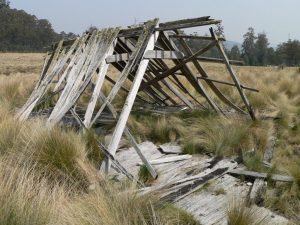
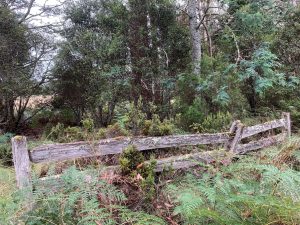
(Left) The gable of the skin shed when still standing at Bramich’s Farm. (Right)
Remains of the post and rail fence. Ian Hayes (left) and Nic Haygarth (right) photos.
Bramich’s farm, Emu Plains
Today the summering of stock in the highlands has almost disappeared. A century ago it was second nature. Agriculture was also practised in frosty places like Erriba, Lorinna and Gads Hill, especially before the economic downturn of the 1920s. Reg told me about his paternal grandparents Fred and Mary Bramich, who had a farm at Emu Plain on the Mersey-Forth high country near Gads Hill. His father Ernest Bramich drove his cattle up to this farm through the summer, producing enough butter there to see his family through the winter.2 Nine-year-old Reg went up there to milk them. Fred Bramich died in 1929, but the Bramich orchard remained in a thriving state—which proved handy for Reg later on when he was working nearby at a sawmill. At night the mill workers would raid the cherry trees.3 For years standing amongst the ruins of the Bramich farm were Roy Davies’ snaring hut and skin shed, but now only sections of post-and-rail fence remain.
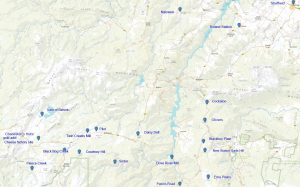
Map by Peter Brown, base map courtesy of LISTmap (DPIPWE).
The hyena and the Hyena Shed
Small gold diggings abound in the headwaters of the Forth. When we walked into Charlestons’ huts at the Vale of Belvoir, Reg showed me the old gold adit. Ironically, while streams dodge in and out of the Vale’s limestone surface and wombats find ready-made limestone holes, the only underground cavity you can stand up in there is a man-made one.
The remains of an old log stockyard are still visible in the centre of the valley. Reg’s maternal grandfather George Williams was also a dairy farmer, and he had a cheese factory for his cattle when they summered on the Vale. There were a few thylacines (aka Tasmanian tigers or hyenas) about up there then, and they were known to have a habit of following people out of curiosity. Reg recalled being told that Williams, while checking his snares near Learys Corner, was surprised to hear his dog pushing his way through the scrub behind him. Surprised because he had tied the dog up. He waited for the dog to catch up, but it never came. On another occasion Williams was skinning some wallabies near Bond Plain when a live wallaby shot past him. A moment later the cause of its haste appeared: ‘This damn hyena come puffin’ along behind this wallaby. They stick to the one and they run ‘em down, they do.’


(Left) The boiler and cheese press of the Williams’ cheese factory still on site in the 1960s. (Right) The same site in the 1990s. The little hut had gone and the track had been relocated through the cheese factory site. Left photo by Roxley Day. Right photo by Nic Haygarth.
As part of the dairying regime, Williams kept pigs in the Vale to feed on the whey and skim milk produced as part of the cheese-making process. At night tigers would come and drink the skim milk out of the pig troughs. Then, in about 1915—Reg thought it was around the year of his birth—Herb Williams captured a tiger in the Vale:
‘He was back there once in the Vale after cattle, and his dogs pulled two out from underneath a big sag, and they caught one and brought it home [to Narrawa] on the horse, tied it in front of him … They built a shed for him. They always used to call it the Hyena Shed … He [the tiger] hung himself in the finish. They killed a beast up in the barn … and they took him up to eat the offal out of the beast that they killed, and he jumped over through this manhole and he hung himself.’4
Reg later used the Hyena Shed as his hunting hut and skin shed, but the building’s ultimate fate is unknown.

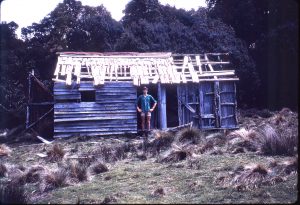
Two old huts in the Vale of Belvoir. Left photo by AW Lord, from the
Weekly Courier, 22 July 1922, p.22. Right photo 1971 taken by Ron Mann.
He remembered visiting the Vale of Belvoir at the age of ten or twelve (in 1925–27), that is, as soon as he could ride a horse.5 George Williams drove cattle and sheep back there for the summer from Narrawa via Geales Hill, Erriba, and the Cradle Mountain Road. Mobs of 40 or 50 wild cattle still roamed places like Pilot (south of the Station House) on Middlesex, in the Fury area (Fleece Creek) and in the Vale. ‘We used to sleep in an old hut, and I’d hear the wild bulls. When you took cattle back they’d smell them and at night time you’d hear ‘em squealin’, roarin’ and carryin’ on as they come down through the scrub. And I used to cover me head, I was only a little fella and I was frightened’. His father used to drive the cheese out on a wagon pulled by bullocks.6 Wild bulls would charge the vehicle, having to be flogged to keep them at bay.7
Building a tramline at Cockatoo (Round Hill)


(Left) Horses hauling an empty bogey on the Cockatoo Mill tramline. (Right) Haines’ Cockatoo Mill workforce.
Photos courtesy of D Weeks.
When Reg was about 21 and still living at Narrawa he worked on the Cradle Mountain Road under various road gangers including Harry Jackman, Ross Glover and Claude Glover. He was working on the road at Black Bog Creek in 1937 when he was offered a job constructing a tramline for FH Haines’ Cockatoo or Round Hill Mill up behind Cethana.8
This was good timing for Reg, because in 1938 he married Freda Wyatt and they settled down in Sheffield.9 The Cockatoo Mill was only 23 miles from Sheffield—by bicycle and foot! To get to work there on Sunday afternoon Reg packed some tucker and biked from Sheffield to the Round Hill Mine at Cethana. After that, with the climb too steep for the bike, he puffed up the hill on foot to his mill lodgings off Olivers Road, opposite the Cockatoo Road turn-off to Lorinna.
Logging of old-growth hardwood forests formed part of the economic recovery following the Great Depression. The main timber in the high country was what bushmen called whitetop (Eucalyptus delegatensis)—not as valuable as browntop (Eucalyptus obliqua) or stringybark (Eucalyptus regnans). Most of Haines’ whitetop was seasoned on site and used for flooring, weatherboards, joinery and furniture. From the beginning of World War Two some was shipped to Sydney, Melbourne and Adelaide. At a time when the State Government wanted to protect its investment in the rail system, timber could be trucked no further than the nearest railway station. Seasoned timber from the Cockatoo sawmill was railed out from Roland Station to Devonport.10
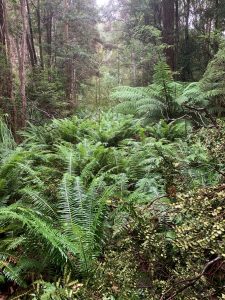 A Cockatoo Mill tramway corridor today.
A Cockatoo Mill tramway corridor today.
Nic Haygarth photo.
The mill was served by a horse-drawn, timber-railed tramway. Above the mill the line climbed Poyntons Hill, past the bullock sheds and out towards the Blackboy and a place called the Wire Paddock. The logs would come down from Poyntons Hill to the mill without horse power, controlled only by a brake. The horses hauled the empty trucks back up to the loading bay at a mossy area called the Featherbeds. Reg’s first job for Haines was to establish a branch tramline which joined up above Poyntons Hill at the Featherbeds. It went out to Myrtle Creek and almost as far as his grandparents’ farm at Emu Plain. At that time sawmill hands worked a 48-hour week, that is five days of nine hours plus three hours on Saturday: ‘I’d work Saturday morning and ride a bike home and go the football Saturday and pack a bit of tucker up Sunday and ride back up to be there Monday morning’.11
Tommy Butler’s mill at New Station, Gads Hill
Reg Bramich also recalled another sawmill on Gads Hill established in 1936 by Tommy Butler, on the Liena side of the Blackboy Plain. He recalled being driven up there via Liena to begin his fourteen-month stint: ‘I had to walk about four mile and carry me gear to find a bullock shed where we camped, and then I had to gather a few manferns together and make a bunch and that’s what I slept on’. After that job he stayed in the area falling whitetop for Mort Warren and Tas Wilcox.12 The services of a good faller were in demand and Reg was long gone by the time the mill burned down at Christmas 1941.
Dove Sawmill remains in the 1990s: (Left) portable boilers, and (centre) building
footings. At right is the (now condemned) bridge over the Forth River serving the mill.
Nic Haygarth photos left and centre. Peter Brown photo at right.
Building the Dove Sawmill
Camping in an old slab snaring hut, in about 1938 Lionel Jones, Reg Bramich and Herbie Bullock built the steam-driven Dove Mill for Claude Davies. It was at a place that snarers Oscar Smith and Henry Hardwick called the Rocks, that is, on the western side of the Forth River above the Dove River confluence. They accessed the site from Patons Road via a bridge (now condemned) over the Forth. Using Davies’ bullock team the trio constructed a road from the bridge to the mill site so that an engine could be hauled in. Later on Lionel Jones operated the Dove Mill on contract for FH Haines, exploiting the forests on both sides of the river.13 Derek Williams carted out up to three loads of timber per day through to the railway at Roland Station or Railton.14
Reg Bramich at the footings of the Daisy Dell Mill (left) in 1994 and on the remains of the plank road on which Teddy
Williams’ bullock team hauled logs out to Haines’ Daisy Dell Mill. More than half a century after its construction, the road had almost disappeared.
Nic Haygarth photos.
Plank roads for bullock teams around Daisy Dell
After that Reg put in fourteen months for sawmiller FH Haines near the Daisy Dell Mill. Daisy Dell—a sawmill and workers’ village near Bob Quaile’s old Daisy Dell property on Bull Creek—had been established by Haines in 1935 to employ workers from the company’s former Mount Barrow Mill.15
Haineses had no tractors until near the end of World War Two (1945), and in the meantime the bullock teams hauled logs out of the bush on paths constructed of some of the poorer eucalypt felled. Planks were placed end to end and nailed onto sleepers beneath with four-inch or six-inch nails.16 Later some of these ‘plank roads’ were taken up and a gravelled formation was created for the use of tractors, bulldozers and, eventually, logging trucks.17
Reg felled whitetop for 11 shillings (55 cents) per day. Teddy Williams’ team of 24 bullocks hauled the logs out on a plank road behind the Mail Tree (Post Office Tree) which extended about 3km across Kerkham’s and Geale’s blocks on the edge of Middlesex. The bullocks were stabled there in a shed, but while Reg camped nearby all week in a hut, Teddy occupied Bob Quaile’s old Daisy Dell homestead. Reg and Teddy would drive back to Sheffield on weekends, with Reg eventually buying an old Indian motorbike.18 Both men departed in high dudgeon after deciding that they were being short-changed by mill contractors Murray Green and ‘Bandy’ Owen.19
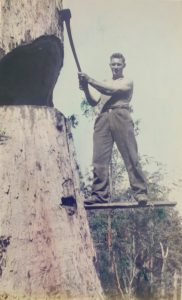
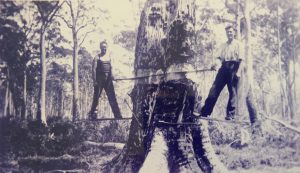
(Left) Reg Bramich falling on Olivers near Tibbly McCoy’s Camp. Most of the work was done with a cross-cut saw like the one demonstrated (right) by two men working near Daisy Dell. They all seem comfortable on their shoeboards. Photos courtesy of Reg Bramich and Wes Goninon respectively.
Haines’ Olivers Mill at ‘the top of Liena’
After two years working at the Stoodley Pine Plantation, sometime after 1940 Reg took a job falling for Haines at the Olivers Mill where four by two planks were produced. He was there four years on £3 per week, again working for mill operator Lionel Jones.20 This mill burned down twice. A few sparks left in the sawdust burner at week’s end was all it took to give the crew returning to work on Monday that familiar experience of building a new mill. The mill also moved twice. The first move was simply because the available resource gradually got too far from the mill. They relocated to what Reg called ‘the top of Liena’, and here he worked on breaking down and benching. Breaking down meant cutting logs into manageable size with a motor-saw. The benchman fed flitches into the vertical saw. Three million feet of timber were racked at the Olivers Mill to dry.21
After the mill was relocated to Sheffield, Reg became a contract faller for FH Haines. In this job he cut a lot of myrtle on a block adjoining Tibbly McCoy’s camp off Olivers Road. A dirt road and a bulldozer replaced the tramline. While Reg was falling, another man hauled the logs out with the bulldozer. ‘It seems silly’, he recalled. ‘They had the mill up there and then they turned around and brought it down to Sheffield and then they sent me up there and they was carting it [the logs] to Sheffield’.22
Reg Bramich at the Twin Creek Mill site, Middlesex, December 1994.
Nic Haygarth photos.
Twin Creeks Mill, Middlesex
FH Haines bought Middlesex Station from JT Field’s estate in 1940 and began to selectively log it.23
They built a ‘spot’ mill (that is, a small, portable sawmill) to cut whitetop on the Middlesex block about 100 metres south of the Cradle Mountain Road. Murray Green and Percy Owen from the Daisy Dell Mill were the operators, and timber from it would have been racked and seasoned at Daisy Dell.24 In 1994 the posts of the mill were still standing, but the walls were on the ground, and little was to be seen of the five workers’ huts about 50 metres further south.
Reg didn’t work at the mill, but logged in the area known as the Sirdar after it closed. Haines pushed their logging road in further, cut King Billy pine at Misery (Courtney Hill) and milled it in Devonport. Acting as Hainses’ sole faller in the area kept Reg’s blood pumping. ‘I’ve felled millions of feet [of timber] … with cross cut saws in Moina and other places, big trees, five or six foot through ‘em’, he reflected. ‘You have to be fit to stick to that. You’ve gotta know a bit about fallin’ ‘em. You’ve gotta have a long-handle axe, and cut your timber the right way, and it’s no trouble’.
I couldn’t let Reg go without asking him about the legendary Middlesex stockman Dave Courtney, who remained at his post while FH Haines ran a few sheep on the highland grazing run. The famously morose Courtney was the last of his breed, a living link to the days of those wild bulls that had snorted their way into Reg’s childhood. ‘I knew old Dave well. He wasn’t a bad old bloke’, he said, recalling his falling days on Middlesex.
Reg revealed that to begin with he and Dave were at a stalemate. While wallaby patties were a welcome supplement to a faller’s tinned menu, keeping shooters off the property was written into Courtney’s duty statement. However, Reg had learned to negotiate, and his currency came with a cork. ‘They wouldn’t let you go on kangarooin’, he laughed, ‘but if you took him [Courtney] a bottle of whisky you could go anywhere’.25
Copyright Nic Haygarth 2020
1 Reg Bramich, interviewed September 1994.
2 Reg Bramich, quoted by Mary Haberle, Mountain reflections, the author, Don, 1993, p.197.
3 Reg Bramich, interviewed 14 September 1994.
4 Reg Bramich, interviewed September 1994.
5 Reg Bramich, interviewed 14 September 1994.
6 Reg Bramich, interviewed 14 September 1994.
7 Reg Bramich, interviewed September 1994.
8 Reg Bramich, interviewed September 1994.
9 Reg Bramich, quoted by Mary Haberle, Mountain reflections, p.202.
10 Henry Haines, interviewed 4 November 1995.
11 Reg Bramich, interviewed 4 November 1995.
12 Reg Bramich, interviewed 4 November 1995.
13 Reg Bramich, interviewed 4 November 1995.
14 Aub Hall, interviewed at Sheffield, 18 April 1995.
15 Henry Haines, interviewed at Deloraine, c1994.
16 Reg Bramich, interviewed 14 September 1994.
17 Henry Haines, interviewed at Deloraine, c1994.
18 Reg Bramich, interviewed 14 September 1994.
19 Reg Bramich, interviewed September 1994.
20 Reg Bramich, quoted by Mary Haberle, Mountain reflections, the author, Don, 1993, p.203.
21 Reg Bramich, interviewed 4 November 1995.
22 Reg Bramich, interviewed 4 November 1995.
23 ‘Important property sale’, Advocate, 11 December 1940, p.10.
24 Henry Haines, interviewed at Deloraine, c1994.
25 Reg Bramich, interviewed 14 September 1994.


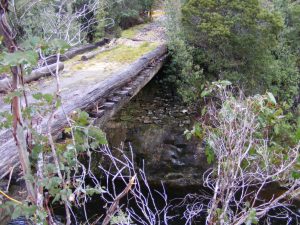
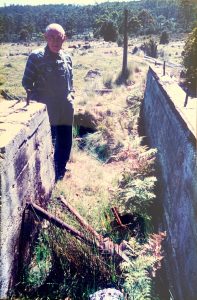
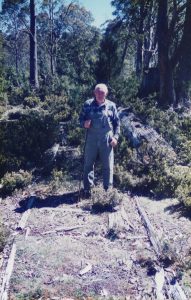
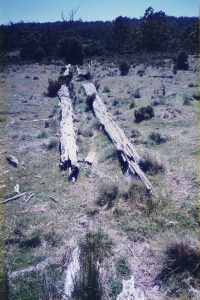
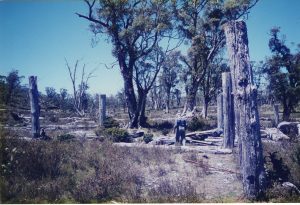
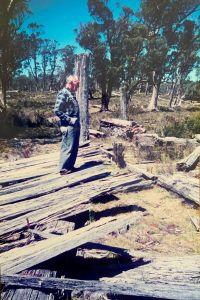
Good reading Peter (Nic actually), thanks for writing up,
A bloke I ‘knew’ from my childhood, but never got to know. He loved greyhounds, well assume such as his wife walked them round Sheffield.
His house block in Sheffield had a King Billy paling fence but after he left it got replaced. Probably not valued for the timber, just some scruffy old palings.
I imagine Reg would have split those himself.
Great reading my grandfather and great uncle George and Harry Vernham snared and hunted Middlesex in the early 1900 as well
Great to hear his name again years after his death
Freda and Reg were like second parents to me.
Beautiful memories
Russell Bramich
Thanks Russell